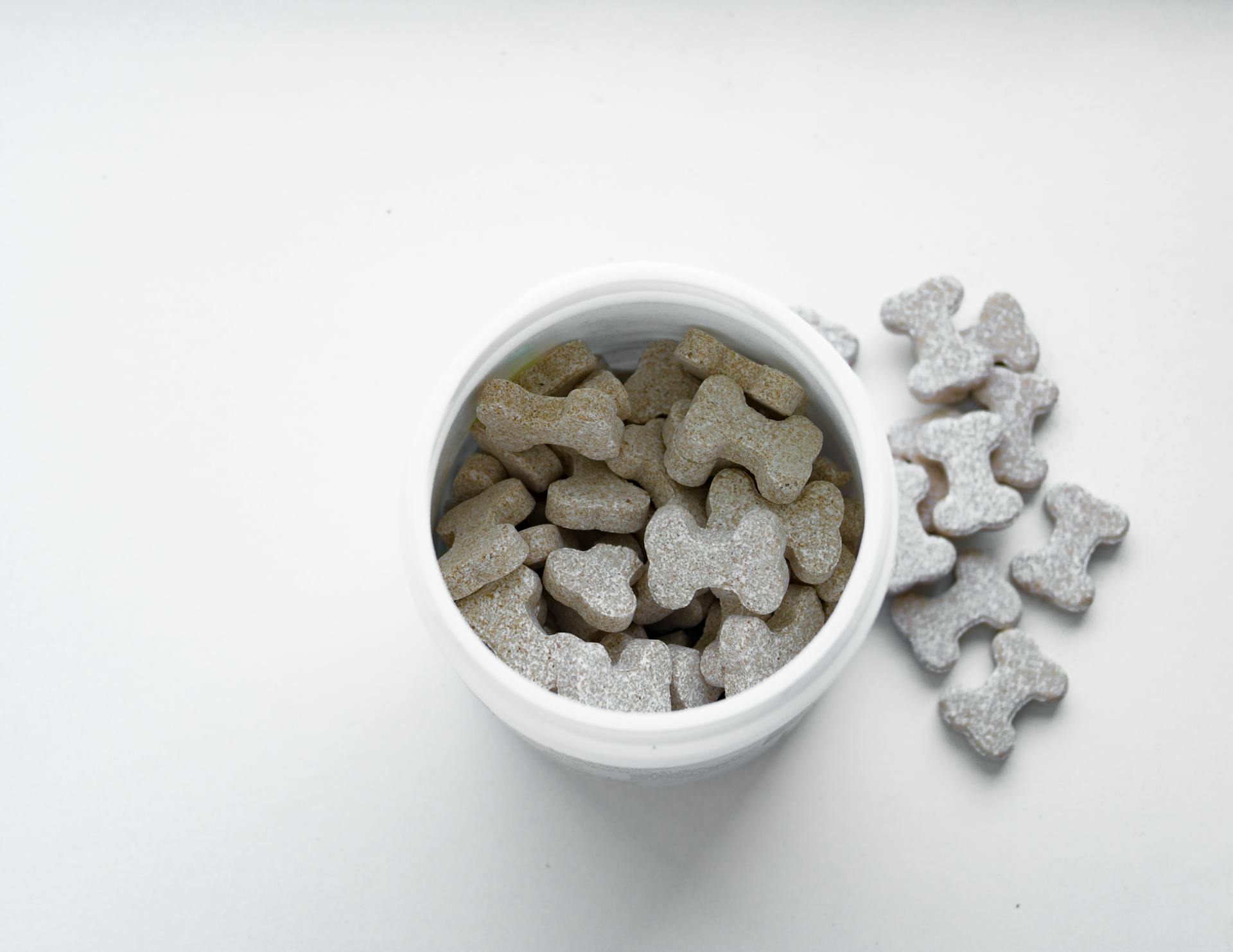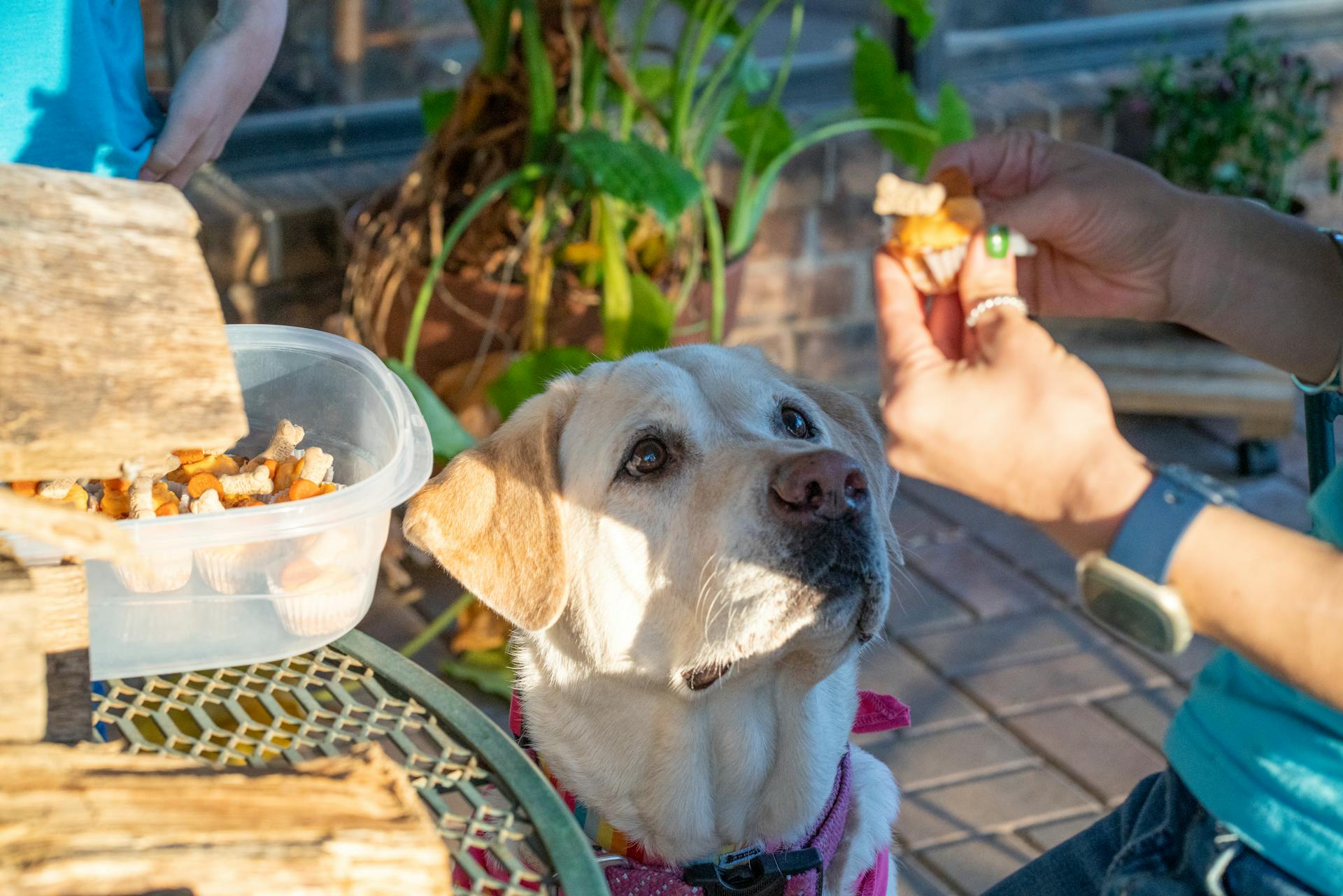
Dog treat training can be a game-changer for beginners, helping to establish a strong bond with your furry friend and teaching them valuable skills.
Start by choosing the right treats, as high-value ones like freeze-dried liver or chicken strips can be most effective.
Using positive reinforcement techniques is key, rewarding desired behaviors with treats and praise to create a positive association.
Treats should be small and easy to consume, making it easier for your dog to focus on the task at hand.
What is High Value?
High-value treats are a crucial part of successful dog treat training. They're moist or freeze-dried, extra smelly, and something your dog doesn't get very often outside of training sessions.
High-value treats can be tiny pieces of chicken, liverwurst, tripe, or even peanut butter (make sure it's xylitol-free) smeared on a spoon. They're essentially an "A+++" for behavior and training.
To choose the right high-value treats, consider what your dog loves and what's good for them. You want to find a balance between high-value treats and your dog's health. Many treats are void of nutrition and loaded with calories and sugar, which can be detrimental to a dog's fitness level.
Some examples of high-quality treats include liver, cheese, dried chicken hearts, and other meats or meat byproducts. These treats only need to be pea-sized, so one bag can go a long way.
Here are some scenarios where high-value treats are particularly useful:
- When first introducing a brand new behavior
- In highly distracting environments, such as a group dog training class
- When rewarding your dog for a quick or high-quality response to a cue
- During important socialization and proactive exposure training for puppies
- If working on counter conditioning as part of a behavior modification plan for leash reactivity, aggression, anxiety, or fear
Choosing the Right Treats
Choosing the right treats for your dog is crucial for successful treat training. Your dog gets to decide what treats they find rewarding, so offer them a few different options to see which they get more excited for.
Some dogs prefer crunchy treats, while others like soft treats. Soft treats usually work best for training sessions because your dog doesn't need to take as much time to chew, and they are less likely to crumble and fall on the floor, which distracts your dog from the task at hand.
There are many types of treats to choose from, including dry, semi-moist, freeze-dried, cooked, or raw. To help you pick out the training treats that your dog will most enjoy and respond to the best, set up a treat taste test for your pup.
Expand your knowledge: Treat Right Dog Treats
Here are some tips for choosing the right treats:
- Protein type: Choose treats based on their protein type, such as fish, poultry, beef, pork, or lamb. Include non-meat-based treats, such as peanut butter.
- Texture: Choose different treat options based on their texture type — dry, semi-moist, jerky, freeze-dried, or wet.
- Ease of Delivery: Choose treats that are easy for you to give your dog, such as pea-sized or smaller treats.
By using a variety of treats, you can create different grades of treats to help your dog improve their training skills and fade out the use of treats in training down the road.
Using Treats as Rewards
Using treats as rewards is a powerful tool in dog training. It's essential to use them correctly to avoid confusion and maintain your dog's interest.
Treats should be given immediately after the desired behavior is achieved, as waiting even a single second can reduce the effectiveness of training. This is because dogs may not have the best memory for what they're being rewarded for.
You want to choose treats that are high-value, but also good for your dog's health. Opt for treats that are nutrient-rich and low in calories and sugar. Some good options include liver, cheese, dried chicken hearts, and other meats or meat byproducts.
Aim for pea-sized treats, as dogs don't care how big they are. This will help your treats go further and make training more efficient.
Here are some scenarios where you can use low-value treats:
- If your dog performs a requested and previously generalized cue, but it's a "C" grade performance
- Throughout the day to encourage continued good behavior
- In low to no distraction training environments
- As part of regular enrichment activities
- When you're working on fading out the use of treats for a specific behavior
Remember, treats should be given as a reward, not a bribe. A reward says "Well done, have this!" while a bribe says "See this? Now do that and you get this."
Explore further: Reward Based Dog Training
Clicker Training
Clicker training is a game-changer for teaching your dog new tricks. Use a clicker to mark the exact moment your dog performs the desired behavior.
You'll want to pair the clicker with high-value treats that your dog loves. Treats need to be of high value to the dog, so skip the everyday fare and opt for something more exciting.
To get your dog to associate the clicker with the treat, follow a simple process: click the clicker and give a treat in rapid succession ten or so times. If your dog gets distracted, click the clicker again and see if they turn back to you.
The key is to use the clicker as soon as your dog performs the desired behavior, so they know exactly what they're being rewarded for.
On a similar theme: Trick or Treat Dog Treats
Common Mistakes and Best Practices
Don't skimp on the treats, as giving them as often as possible for good behavior is crucial for successful training. This means tossing out treats even when you're not actively conducting a training session.
Giving treats the instant your dog performs the desired behavior is key, as rewarding the wrong behavior can hinder progress. If you ask for a "sit" but reward getting up, you've essentially taught your dog to get up instead of sit.
Rewarding your dog immediately after they perform the desired behavior is essential for successful training.
What Is a Bribe?
A bribe in dog training is using a treat or reward to lure your dog into doing a behavior, rather than earning it through their actions. This is different from using a treat as a reinforcer, which is a payment for a job well done.
Using a treat to lure your dog into doing a behavior is like showing them a piece of cheese and then calling them to come, hoping they'll follow you because they saw the treat.
For another approach, see: Dog Training Lure Stick

At the beginning of training a new cue, the treat makes the behavior happen. But as you train, you want the behavior to make the treat happen.
For example, if you're teaching your dog to come when called, you might start by showing them a treat and then saying "come." But as they learn the cue, you want them to come because they want the treat, not because they saw it first.
Common Mistakes
Don't skimp on treats, as this can hinder the training process. Giving treats "as often as possible for anything your dog does right" is a great approach.
Using treats that are too big can be a problem, as they can take too long to eat and disrupt the training session. Keeping treats pea-sized is a good rule of thumb.
Rewarding the wrong behavior can be a common mistake. If you present a treat where your dog has to get up to get it, you're actually rewarding getting up, not the desired behavior.
Using food treats as a bribe is not a good idea. Instead, use food as a lure to make a behavior happen and then switch to the behavior making the food happen.
You should monitor your dog's caloric intake when starting a training program, as they can quickly become overweight. A general rule of thumb is that training treats shouldn't be more than 10% of your dog's daily food intake.
Broaden your view: Dog Training Food
Finding a Qualified Trainer
Finding a Qualified Trainer is crucial for your dog's well-being and your peace of mind. According to a pro, you should ask the right questions to find the right trainer for your dog.
The first question to ask is what experience and credentials the trainer has. A pro suggests looking for trainers with experience in training dogs with specific needs, such as puppies or dogs with behavioral issues.
You should also ask about their training methods and philosophy. A pro recommends looking for trainers who use positive reinforcement methods, which are gentler and more effective in the long run.
Check this out: Dog Training Schools for Trainers
Some trainers may claim to be certified, but it's essential to verify the certification. A pro suggests checking with professional organizations, such as the Certification Council for Professional Dog Trainers (CCPDT).
A good trainer will also have a clear plan and communication plan in place. According to a pro, look for trainers who will work with you to set goals and provide regular updates on your dog's progress.
Ultimately, finding the right trainer takes time and research. A pro suggests asking for referrals from friends, family, or veterinarians, and then doing your own research to find the best fit for you and your dog.
Take a look at this: Dog Training Plan
Sources
- https://www.preventivevet.com/dogs/what-kind-of-treats-should-you-use-to-train-your-dog
- https://www.businessinsider.com/guides/pets/best-dog-training-treats
- https://www.preventivevet.com/dogs/how-to-use-dog-treats-the-right-way-in-dog-training
- https://www.theartofdoingstuff.com/make-1000-dog-training-treats/
- https://www.thewildest.com/dog-behavior/using-dog-treats-for-training
Featured Images: pexels.com


